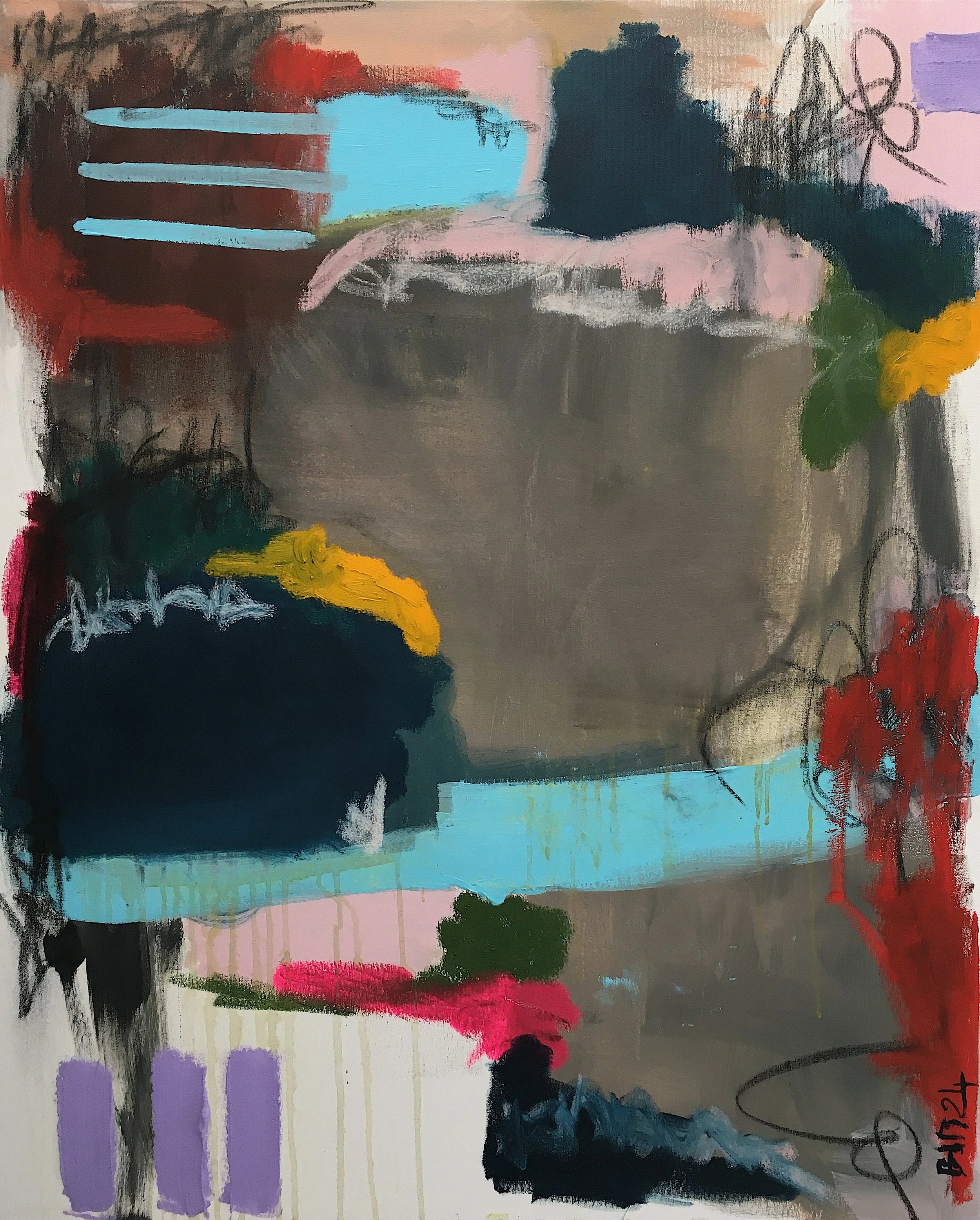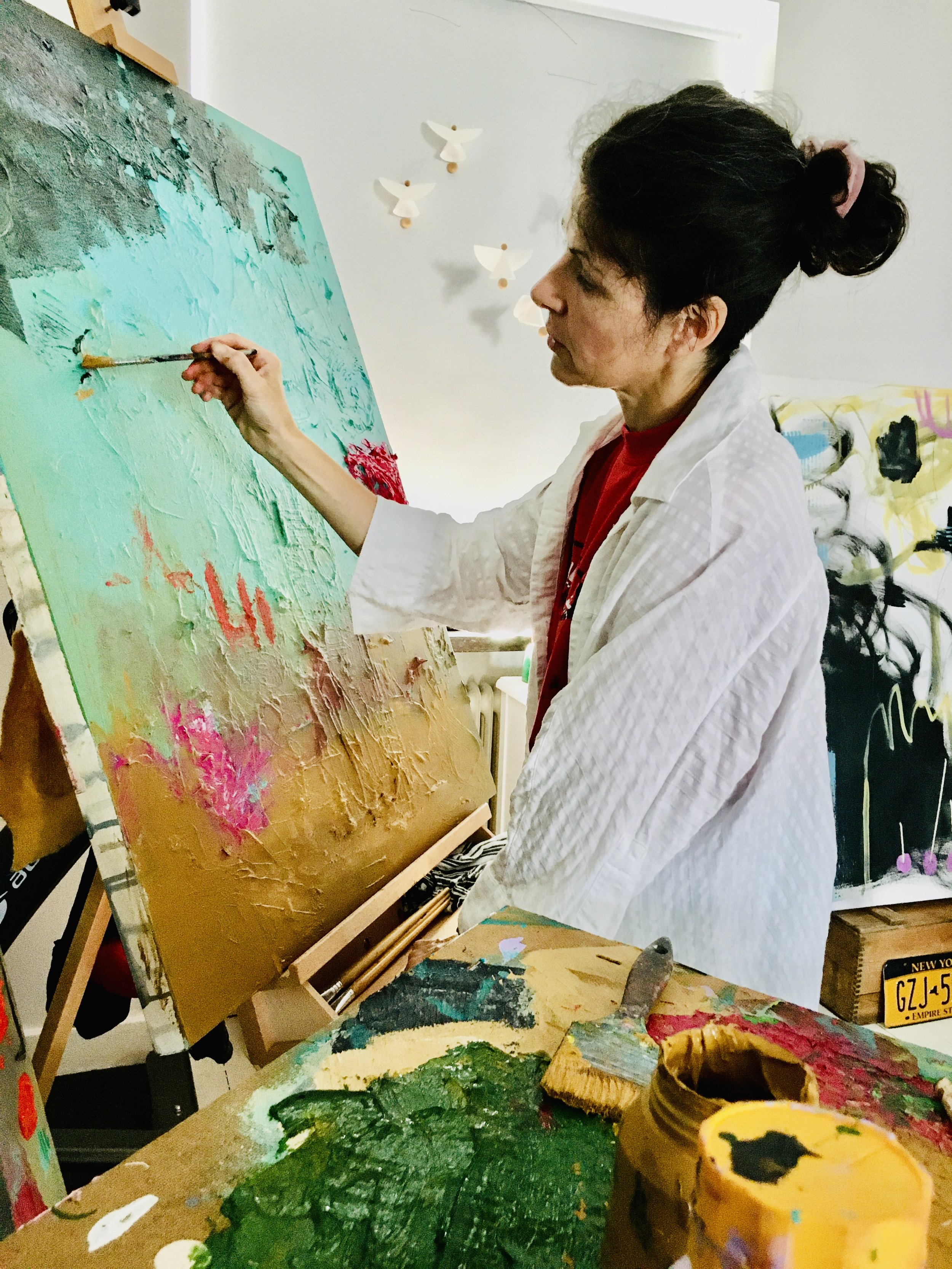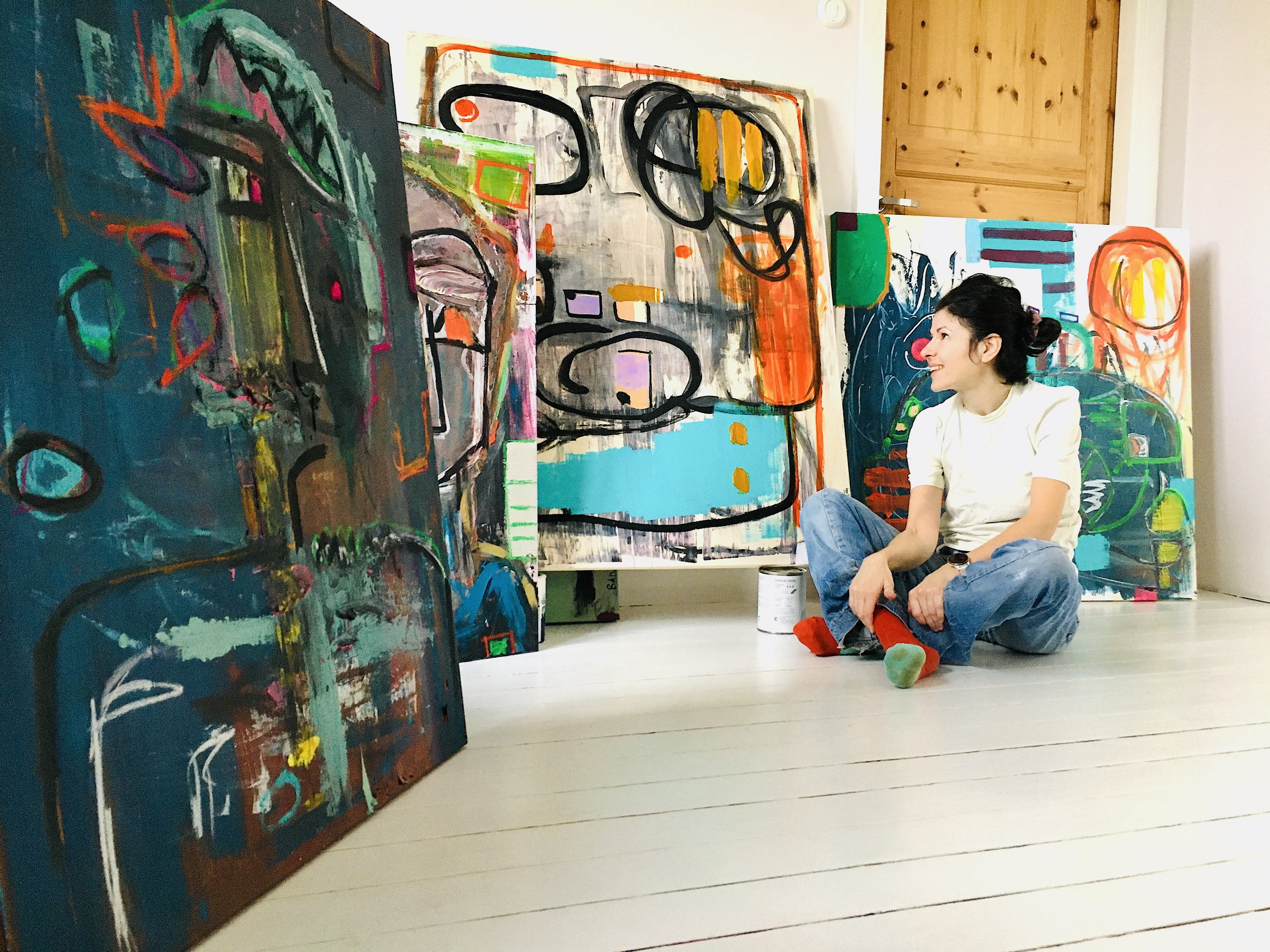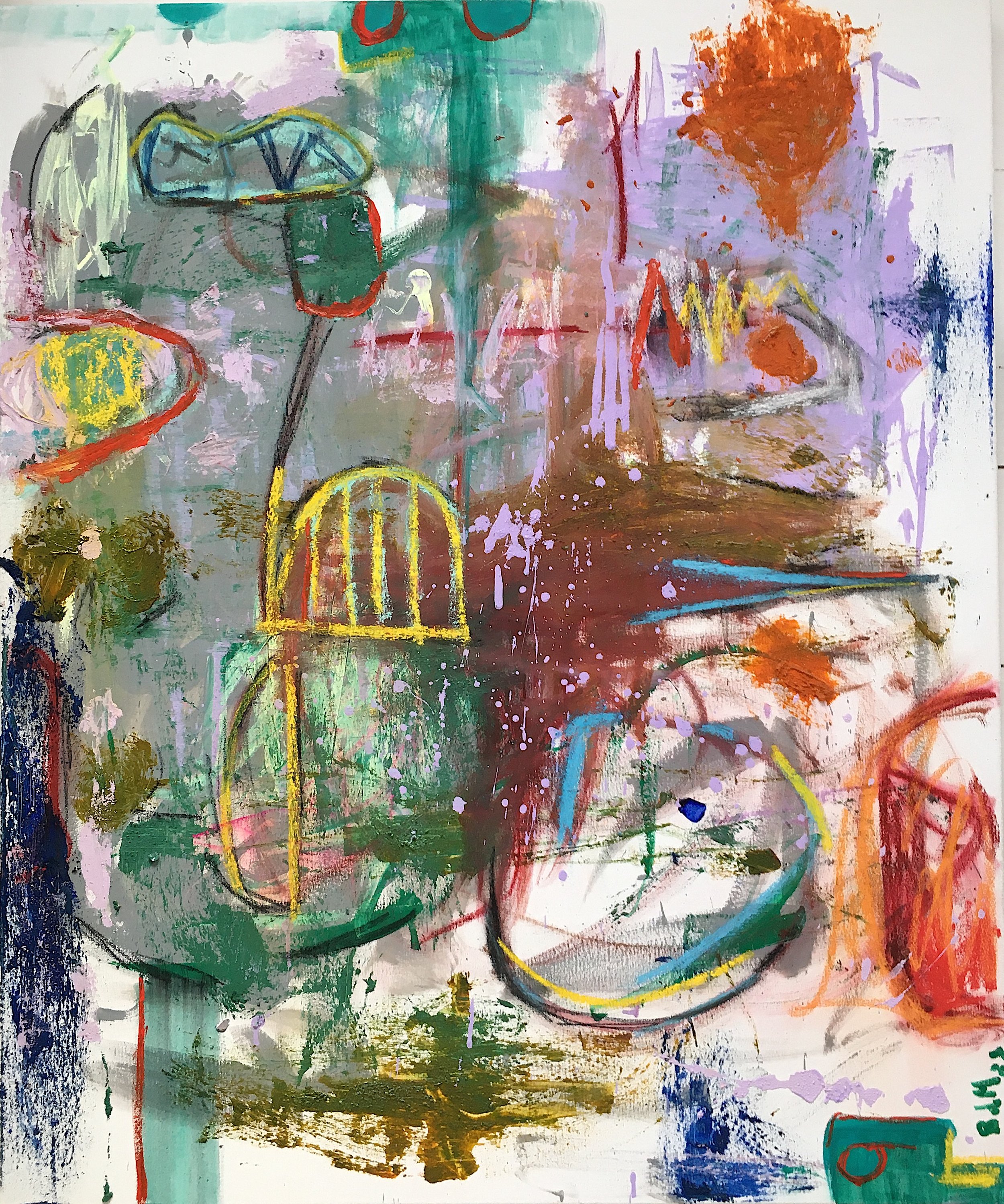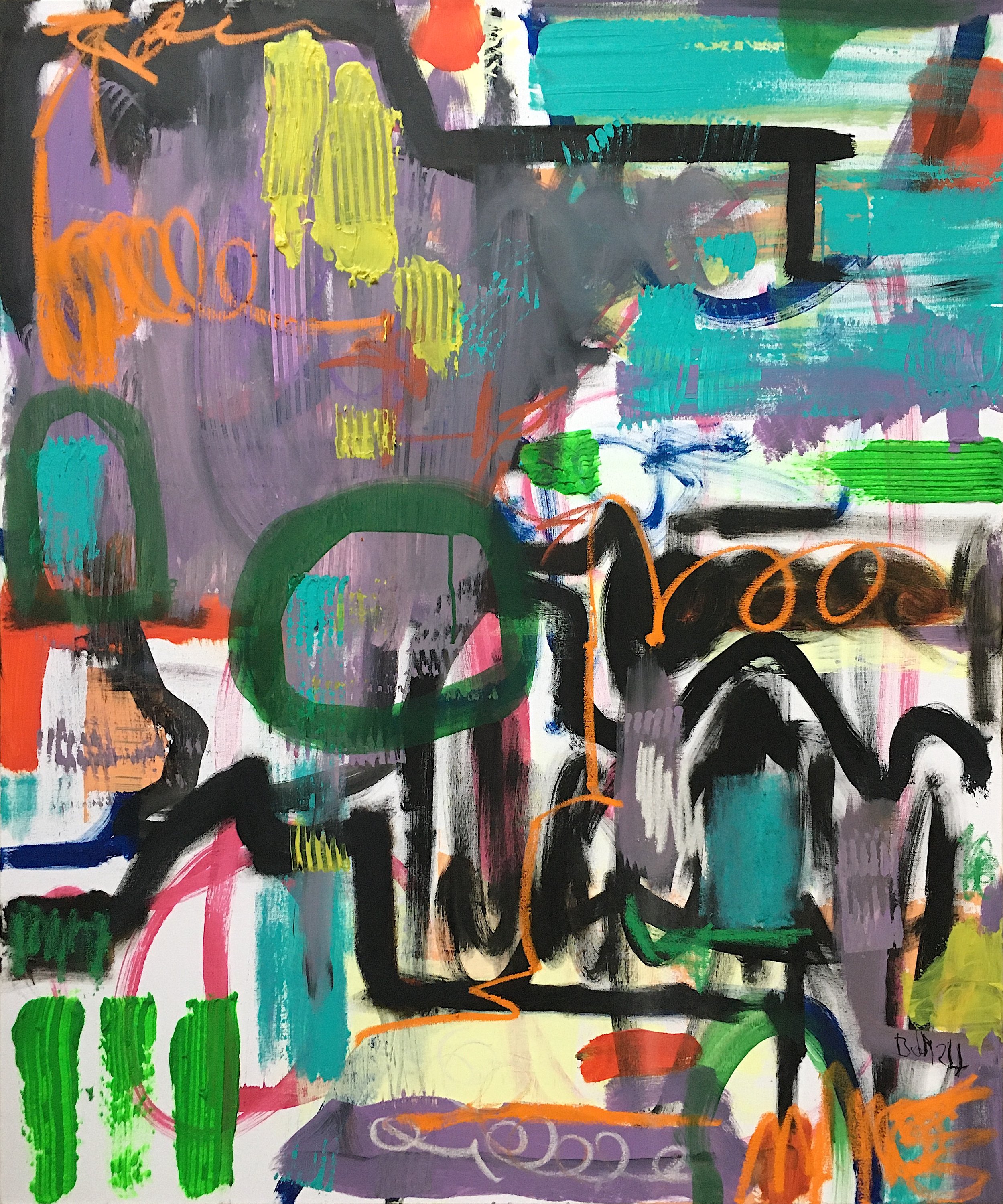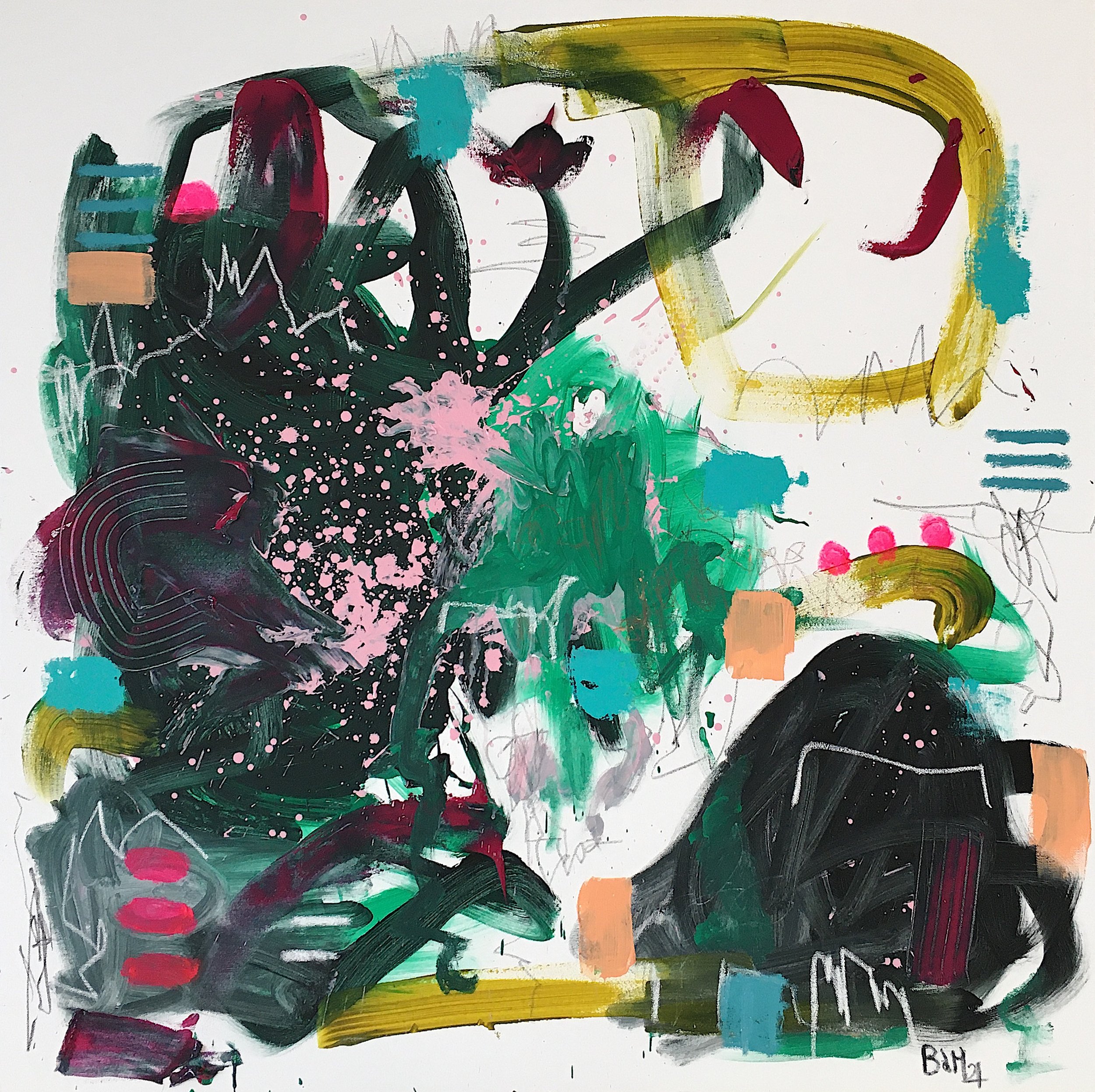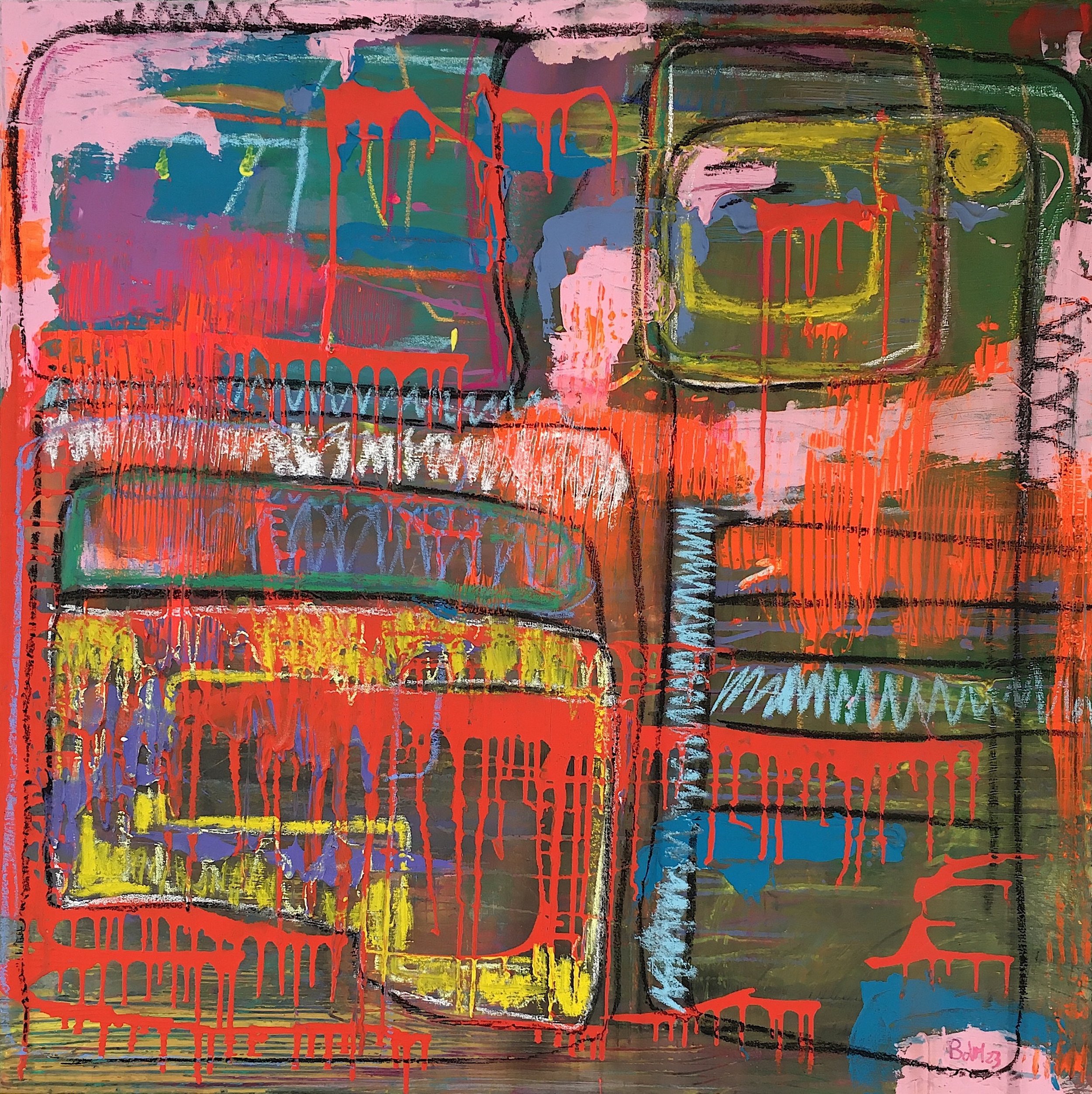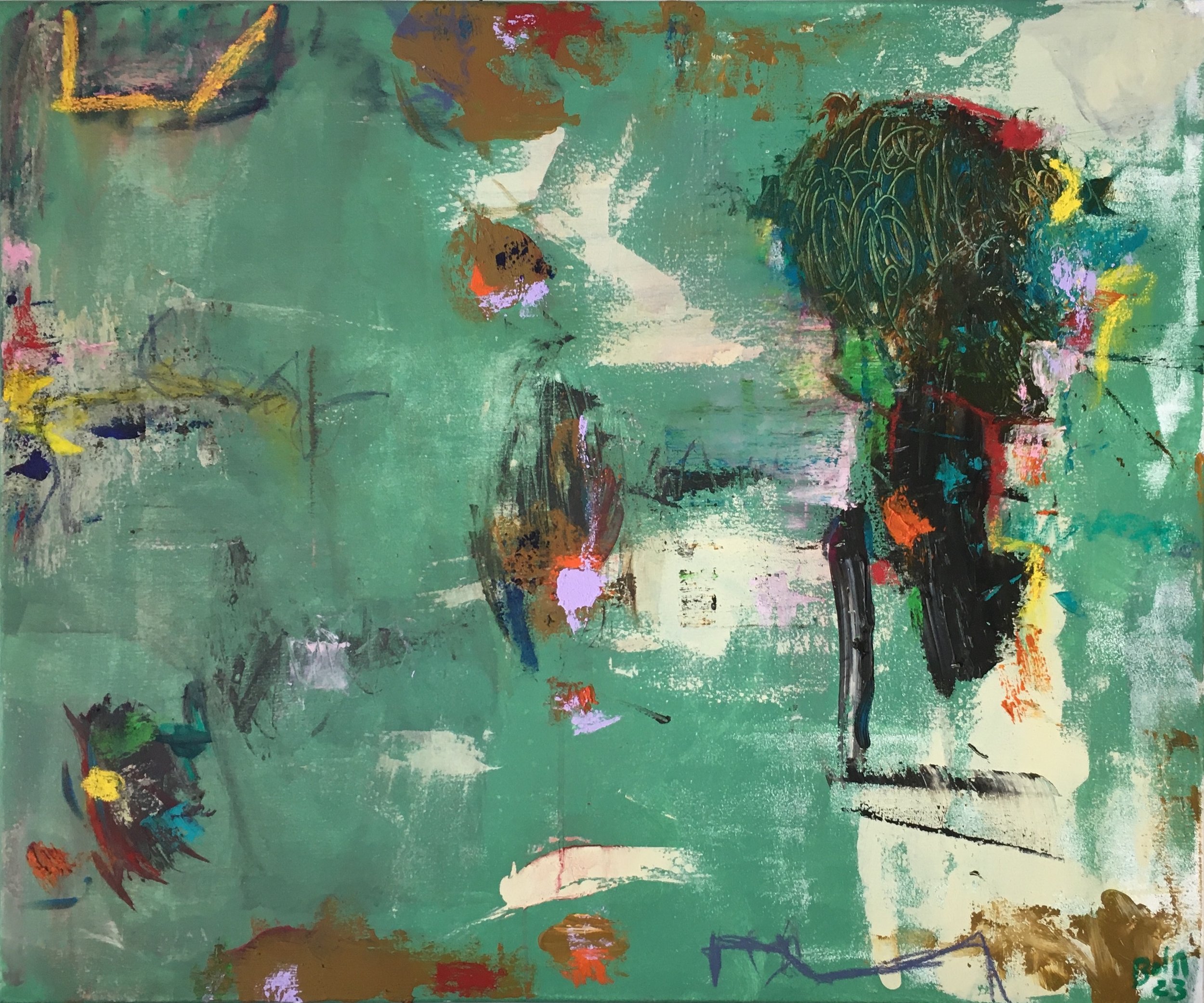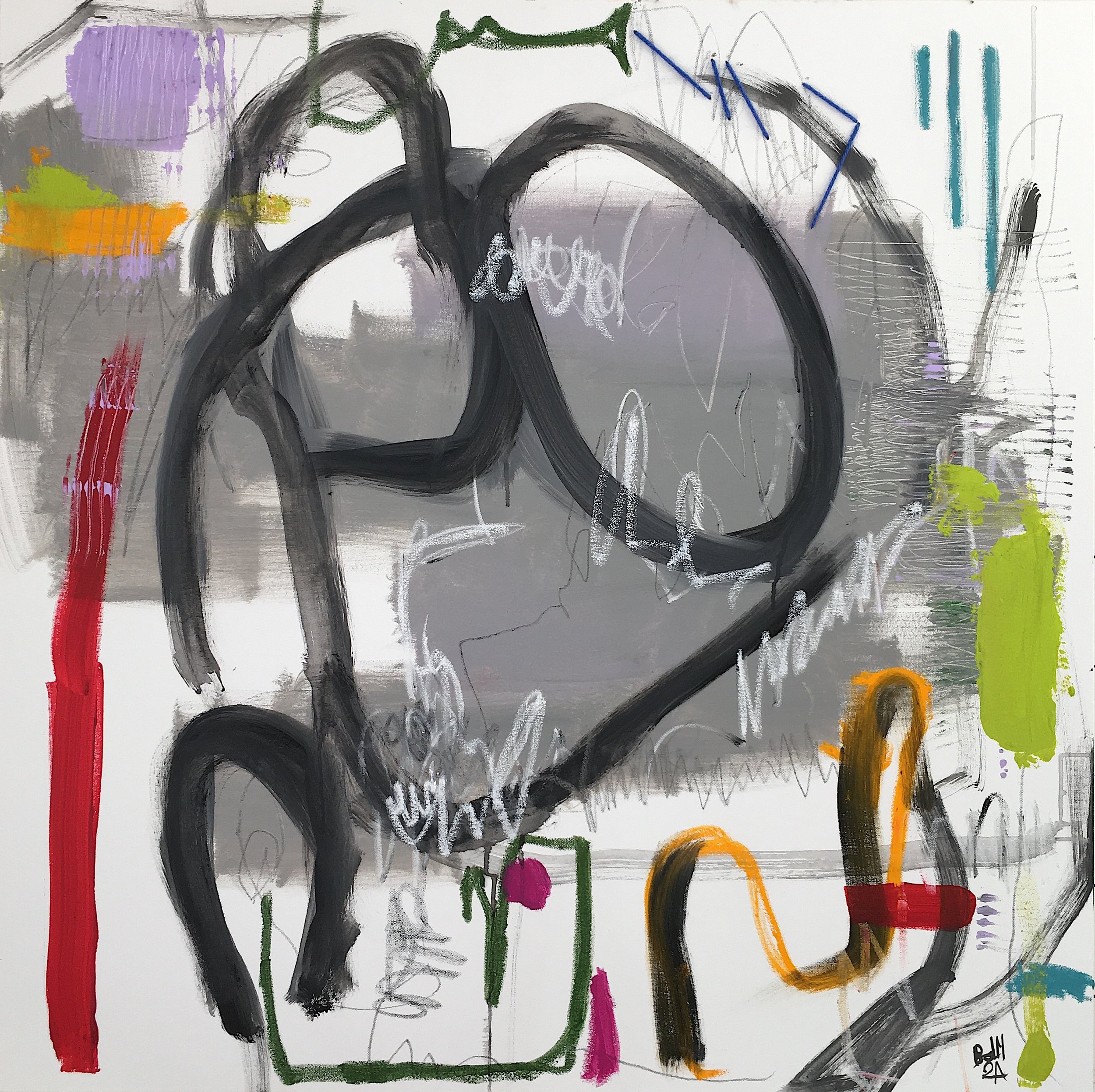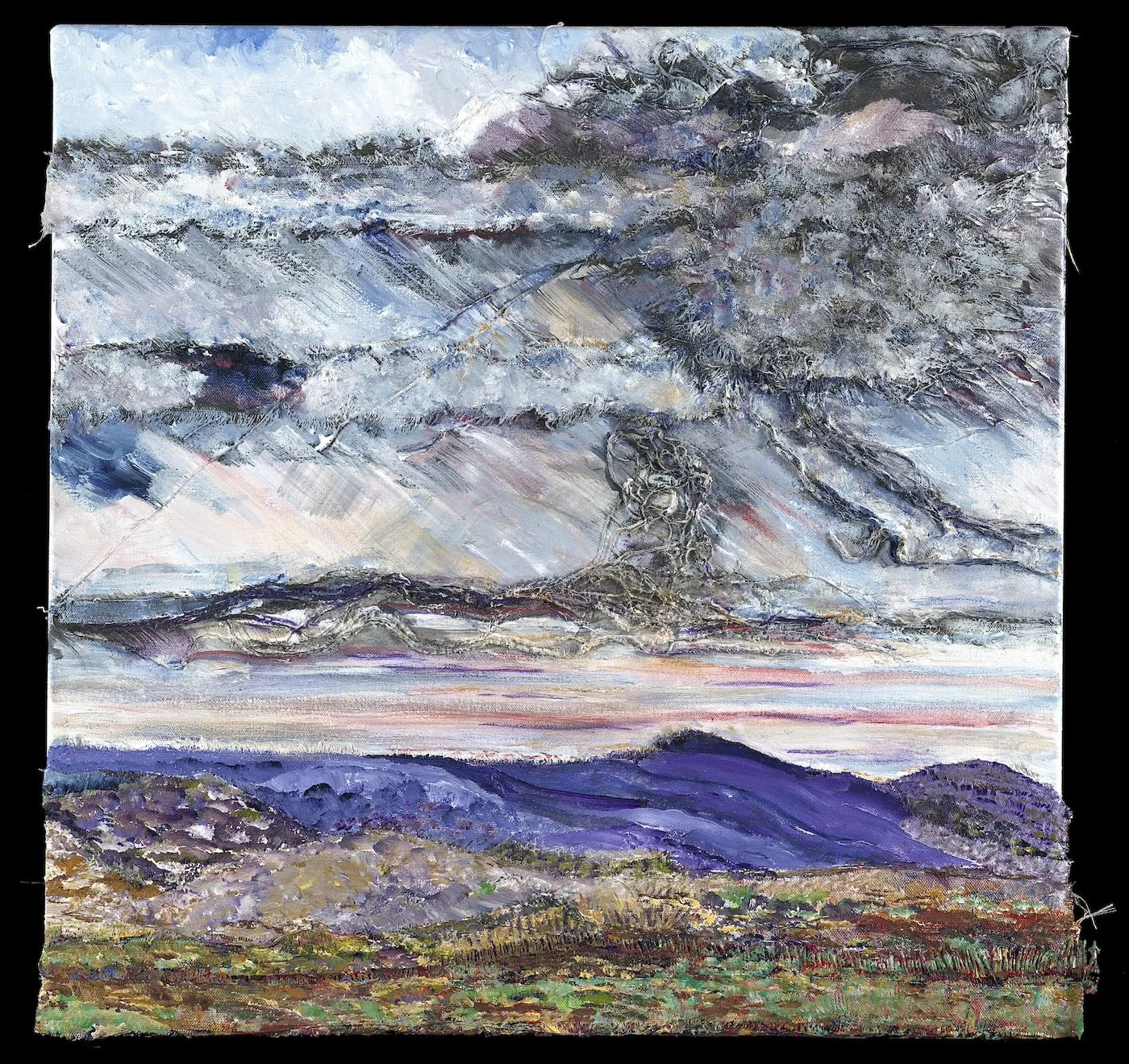Interview with Barbara D'Angelo Månsson
Italian/Swedish artist living and working in Sweden, I draw inspiration from the diverse artistic heritage of Scandinavia and the vibrant essence of American Abstract Expressionism. Beginning my creative voyage with drawing and photography, I ultimately found my artistic voice in the realm of abstract painting.My artistic process involves intertwining impasto techniques with unconventional materials like sand, plastic, metal and paper, resulting in structured canvases that beckon viewers to explore their tactile surfaces. By incorporating ink, charcoal and/or oil pastels, I achieve a dynamic and intricately layered effect that infuses my pieces with depth and visual complexity.At the core of my artistry lies a profound exploration of human nature and its enduring impact on the world. Through my abstract compositions, I endeavor to unravel the intricacies of human emotions, experiences, and interactions, presenting audiences with a visual narrative that echoes with introspection and contemplation.
Your work often incorporates unconventional materials such as sand, along with traditional mediums like acrylics. How do you determine which materials to incorporate into a piece? What is the significance of these materials in terms of texture, depth, and the overall narrative you aim to convey? Can you share an example where the choice of material played a crucial role in the interpretation of your artwork?
I typically choose materials based on the specific concept or emotion I aim to convey in my artwork. The decision to incorporate unconventional materials like sand alongside traditional mediums such as acrylics is often driven by a desire to create contrast, texture, and depth in my pieces. I have created "The Long Journey to Find Yourself," using sand to depict a figure symbolizing my life's struggles. My choice of incorporating unconventional materials like sand alongside traditional mediums such as acrylics is a deliberate and thoughtful process.
When deciding which materials to use in a piece, I consider the narrative I want to convey and the emotions I aim to evoke. For me, each material carries its own unique qualities and symbolism. Sand, with its granular texture and earthy tones, adds a tangible depth to the painting. It allows me to create layers and textures that not only represent the physical journey of life but also the emotional depth of the struggles faced along the way.
In this specific artwork, the use of sand is pivotal in conveying the sense of a challenging and arduous journey. The rough texture of the sand brings a tactile quality to the piece, inviting viewers to not only see but also touch and feel the hardships depicted in the painting.
With a PhD in Molecular Biology, your background is deeply rooted in science. How does this scientific foundation influence your approach to art, particularly in your methods of observation, experimentation, and inquiry? Can you describe a specific piece where the precision and curiosity inherent in scientific research are reflected in your artistic process and the themes explored?
Having a PhD in Molecular Biology has undeniably shaped the way I approach art. In my scientific background, my core essence lies in a profound curiosity for uncovering and experimenting with novel concepts. This curiosity drives me to constantly seek new discoveries and explore uncharted territories.
One of the most vivid examples of this approach is reflected in my artwork, specifically in my painting "Memorie Sospese." In this piece, I deliberately combined elements of wool and wood to experiment with a fresh and innovative artistic approach. By intertwining these materials, I aimed to push the boundaries of traditional art forms and create a piece that not only stimulates the visual senses but also challenges conventional artistic norms.
Through my scientific background and artistic pursuits, I embrace a philosophy of exploration and experimentation, constantly striving to uncover new perspectives and push the boundaries of creativity. This multidimensional approach defines my identity as a curious and innovative individual who is passionate about both science.
You’ve mentioned that your artistic process often begins intuitively, with a color or texture that resonates with you at that moment. How do you balance this intuitive approach with the structured, methodical approach often required in scientific research? How do you ensure that your work remains both spontaneous and coherent throughout the creative process?
In my artistic process, I find that my inspiration often stems from an intuitive connection to a specific color or texture that speaks to me in that moment. This initial spark is crucial in guiding the direction of my artwork and setting the tone for the piece.
Balancing this intuitive approach with the structured and methodical nature of scientific research is a delicate yet rewarding endeavor. While the two realms may seem divergent, I see them as complementary forces that fuel my creativity and critical thinking simultaneously.
To maintain spontaneity and coherence in my work, I often start with that intuitive impulse but then transition into a more structured phase where I analyze, plan, and refine my ideas. Much like a scientific experiment, I experiment with different techniques, materials, and compositions. I utilize my rational thinking to ensure that the elements in my artwork harmonize with the initial intuitive spark, creating a cohesive and meaningful piece.
In what ways do you see your art as a bridge between the personal and the universal? How do you hope viewers will connect with the emotions and experiences reflected in your work? Can you discuss how you translate complex feelings and concepts into visual narratives that resonate with a broad audience?
For me, art serves as a powerful bridge between the personal and the universal, offering a space where my individual experiences and emotions can find resonance with a broader audience. In my works, I strive to delve into the depths of my own emotions and experiences, using them as a foundation to explore universal themes that speak to the human condition.
I hope viewers will connect with my art on a visceral and emotional level, seeing themselves reflected in the nuances of the colors, shapes, and textures that compose each piece. By tapping into shared human experiences of love, loss, triumph, and struggle, I aim to evoke a sense of empathy and understanding that transcends individual narratives.
Translating complex feelings and concepts into visual narratives that resonate with a broad audience is a nuanced process that involves distilling emotions into their purest forms and weaving them into a cohesive visual language.
Transitioning from drawing with charcoal, ink, and chalk to embracing painting represents a significant evolution in your artistic journey. How has this transition influenced your expression and opened up new possibilities for your work? Can you reflect on a specific piece or period in your career where this shift was particularly transformative?
Transitioning from drawing to abstract painting has been a profound journey for me. The shift from working with charcoal, ink, and chalk to embracing the world of painting has opened up a whole new realm of creative possibilities and expression.
This transition has deeply influenced my artistic voice and allowed me to explore a more fluid and interpretive way of creating. Through the use of colors, shapes, and textures in abstract painting, I have found a greater freedom to convey emotions and concepts in a way that goes beyond traditional drawing mediums.
"The Struggle" is a painting that encapsulates this transformative shift in my artistic path. In this piece, I have used dynamic brushstrokes, a contrasting color palette, and layers of emotion to symbolize the challenges and triumphs of this transition.
Looking back on a specific period in my career where this shift was particularly transformative, I recall a series of paintings ” Searching for the Monochrome ” where I fully embraced abstraction. During that time, I noticed a profound change in how I approached composition, color theory, and the overall emotional resonance of my work.
Embracing abstract painting has allowed me to delve deeper into my imagination and share my unique perspective with the world. It has sparked a new level of creativity and experimentation in my art, bringing a fresh sense of inspiration and possibility to my artistic journey.
Your use of impasto and layering techniques adds a tactile and visual depth to your paintings. How do you approach the creation of these layers, and what do they symbolize in the context of the stories you are telling? Can you explain your process of layering and how it contributes to the dynamic and luminous quality of your work?
Creating layers in my paintings through impasto and layering techniques is a vital part of my artistic process. These techniques not only add tactile and visual depth to my work but also serve to enrich the narratives I aim to convey through my art.
When approaching the creation of these layers, I strive to build up textures and depths that speak to the emotions and stories within each piece. Each layer represents a different aspect of the narrative I am telling, adding complexity and richness to the overall composition.
In the context of the stories I am sharing, these layers symbolize the depth of human experience, the passage of time, and the complexity of emotions. Each layer is like a chapter in a story, adding nuances and intrigue to the visual narrative.
My process of layering involves applying thick, textured paint using impasto techniques to create a sense of physicality and depth. By building up these layers, I create a dynamic interplay of light and shadow, color and form, which contributes to the luminous quality of my work.
Through careful consideration of color, texture, and composition in each layer, I aim to evoke a sense of depth and movement within the painting. The layering process allows me to explore the subtleties of light and shadow, creating a visual depth that draws the viewer in and invites them to immerse themselves in the story unfolding on the canvas.
Overall, the layering techniques I employ are not just about creating visual interest; they are integral to the storytelling aspect of my art. Each layer adds another dimension to the narrative, enriching the viewer's experience and inviting them to explore the layers of meaning and emotion within the painting.
Both art and science involve exploration, discovery, and a deep understanding of the world. How do you navigate the tensions and synergies between these two fields in your work? Can you provide an example where your scientific background directly influenced a piece of art, either in concept or execution?
Balancing the realms of art and science in my creative endeavors has always been a fascinating journey. Both fields, despite their apparent differences, share a fundamental essence of exploration, discovery, and a profound understanding of the world around us.
In my painting "Unstructured," I embrace an organic and free-flowing process akin to the initial stages of scientific idea generation. This painting captures the essence of brainstorming and the often chaotic yet stimulating nature of exploration and creativity.
On the other hand, "Pink Attitude" embodies a more structured and methodical approach, mirroring the disciplined and systematic nature of scientific inquiry. Here, I follow a clear path of creation, incorporating precision and order into the artistic process, much like the structured methodology employed in scientific research.
The interplay between these two approaches— the unstructured and the structured— in my artistic practice not only enriches the creative process but also yields a diverse range of outcomes. While art allows for imaginative freedom and expression, science brings in analytical thinking, organization, and a meticulous attention to detail.
By seamlessly weaving together elements of scientific methodology and artistic expression, as illustrated in the paintings " Unstructured" and "Pink Attitude," I strive to create works that not only captivate the senses but also invite contemplation on the harmonious relationship between art and science in the realm of creativity.
Having lived in Italy, Sweden, and the USA, your cultural experiences are diverse and rich. How have these varied cultural landscapes influenced your artistic voice and the themes you explore in your work? Can you describe how specific cultural elements from these countries have manifested in your art?
I have been fortunate to have lived in Italy, Sweden, and the USA, and the cultural tapestries of these diverse countries have profoundly shaped my artistic voice and the themes I delve into through my work.
I was born and raised in Italy, but later on in life, I firsh relocated few years in USA and subsequently in Sweden, where I currently live. My childhood in Italy, with its rich history of art and culture, has instilled in me a deep appreciation for beauty, craftsmanship, and a sense of timelessness. The vibrant colors, intricate patterns, and architectural wonders of Italy have seeped into my art, inspiring me to explore themes of tradition, heritage, and the enduring power of beauty.
Living in the USA has exposed me to a melting pot of cultures, ideas, and perspectives, particularly Abstract Expressionism and the Pop Art movement. I was fascinated by the aesthetic of Jackson Pollok works and the vibrant minimalism of Mark Rothko. This diversity has infused my art with a sense of inclusivity, exploration, and innovation. The energy, dynamism, and creativity of the American landscape have inspired me to push boundaries, experiment with new techniques, and explore a wide range of themes in my work.
In Sweden, I was captivated by the simplicity, harmony, and connection to nature that permeated the culture. This experience influenced my artistic style, leading me to embrace minimalism, clean lines, and a sense of serenity in my work. The Swedish design ethos of functional elegance and natural elements have found their way into my art, guiding me to explore themes of balance, simplicity, and the profound beauty of the natural world.
Specific cultural elements from these countries have manifested in my art in subtle yet profound ways. From the warm hues of Italian sunsets to the clean lines of Scandinavian design to the bold experimentation of American art movements, each cultural influence has left its mark on my artistic expression. These varied experiences have enriched my creative vision, allowing me to draw inspiration from a multitude of sources and craft a narrative that is both personal and universal.
Your pieces often invite viewers to engage closely, offering layers of meaning and texture that reward careful inspection. What role do you believe the viewer plays in completing the narrative of your artwork? How do you design your pieces to facilitate this interaction, and what responses have you observed from your audience that have particularly struck you?
As an artist, I believe the viewer plays a crucial role in completing the narrative of my artwork. I see the viewer as an active participant in the interpretation and understanding of my pieces. By offering layers of meaning and texture, I aim to spark curiosity and encourage viewers to engage closely with the artwork, allowing them to discover new details and nuances with each inspection.
In designing my pieces, I strive to create a balance between clarity and ambiguity, leaving room for individual interpretation and personal connection. I often incorporate symbolic elements or subtle references that prompt viewers to reflect on their own experiences and emotions, thus forming a unique narrative in their minds.
The responses I have observed from my audience have been diverse and fascinating. Some viewers have shared personal stories or interpretations that resonated deeply with the themes of my artwork, while others have noticed details or connections that I had not initially intended. I have been particularly struck by the emotional responses elicited by my pieces, witnessing viewers express joy, sadness, nostalgia, or introspection in the presence of my artwork. It is truly rewarding to see how each viewer brings their own perspective and experiences to complete the narrative of my work.
As you continue to evolve as an artist, are there any new materials, techniques, or themes you are excited to explore? How do you envision these explorations contributing to the ongoing dialogue in your body of work? Can you share any upcoming projects or ideas that represent the next phase of your artistic journey
As I continue to evolve as an artist, I am currently exploring new materials, techniques, and themes in my ongoing project called "Materials ," where I combine wool, wood, and metal with acrylic to create rich textures and visual contrasts. This project delves into the interplay between natural and industrial elements, inviting viewers to engage with the pieces on multiple sensory levels.
In the near future, I plan to develop a new project called "Distorted Perspective," where I will paint in unconventional positions or introduce physical constraints to represent reality from alternative viewpoints when movement is restricted or unconventional. This upcoming project will delve into themes of limitations, freedom, and perception, challenging viewers to reconsider their perspectives on art and reality.
By blending different materials in my "Material" project and exploring unconventional painting techniques in "Distorted Perspective," I aim to create a dynamic dialogue within my body of work that challenges traditional artistic practices and evokes deeper emotional responses from the audience.

